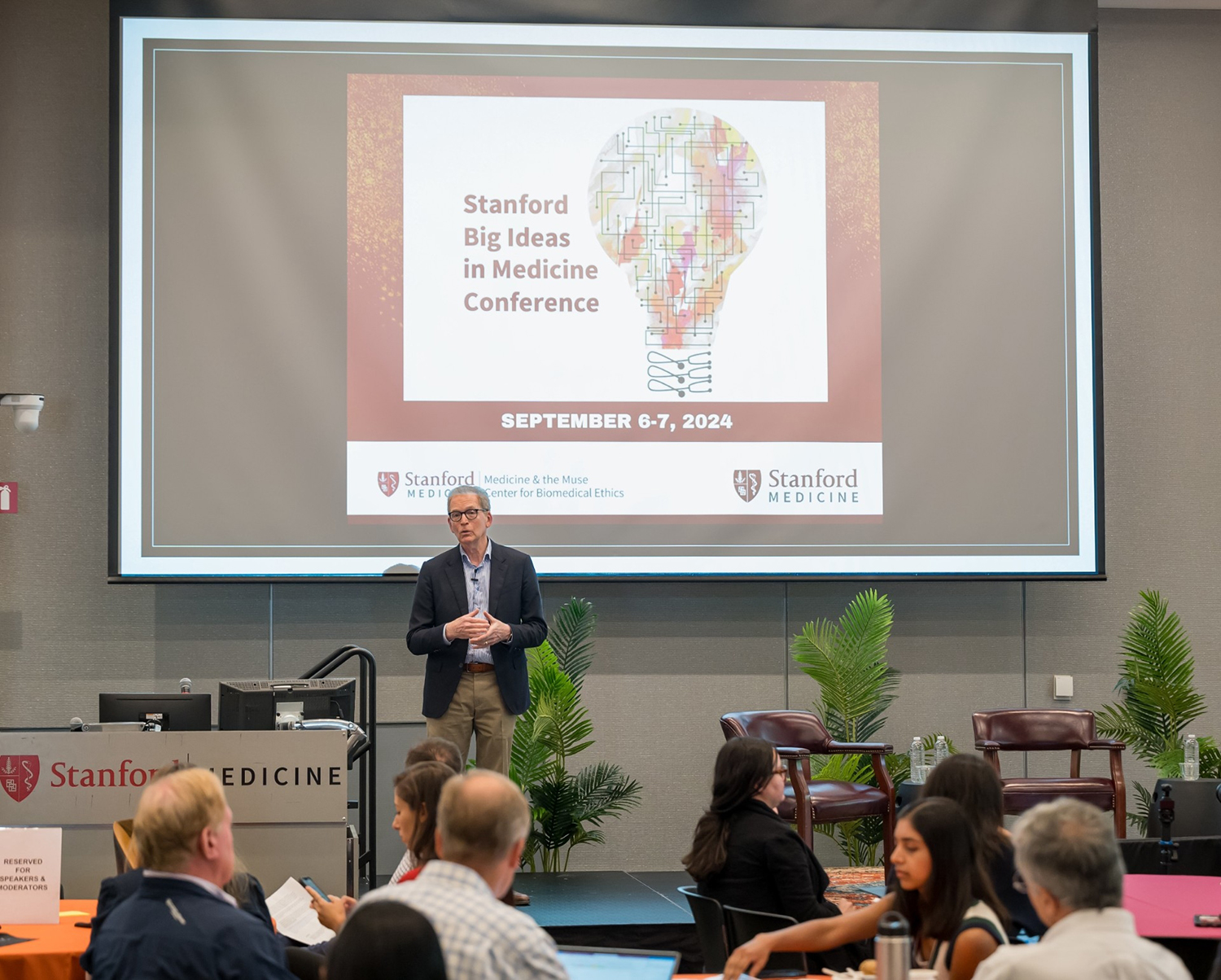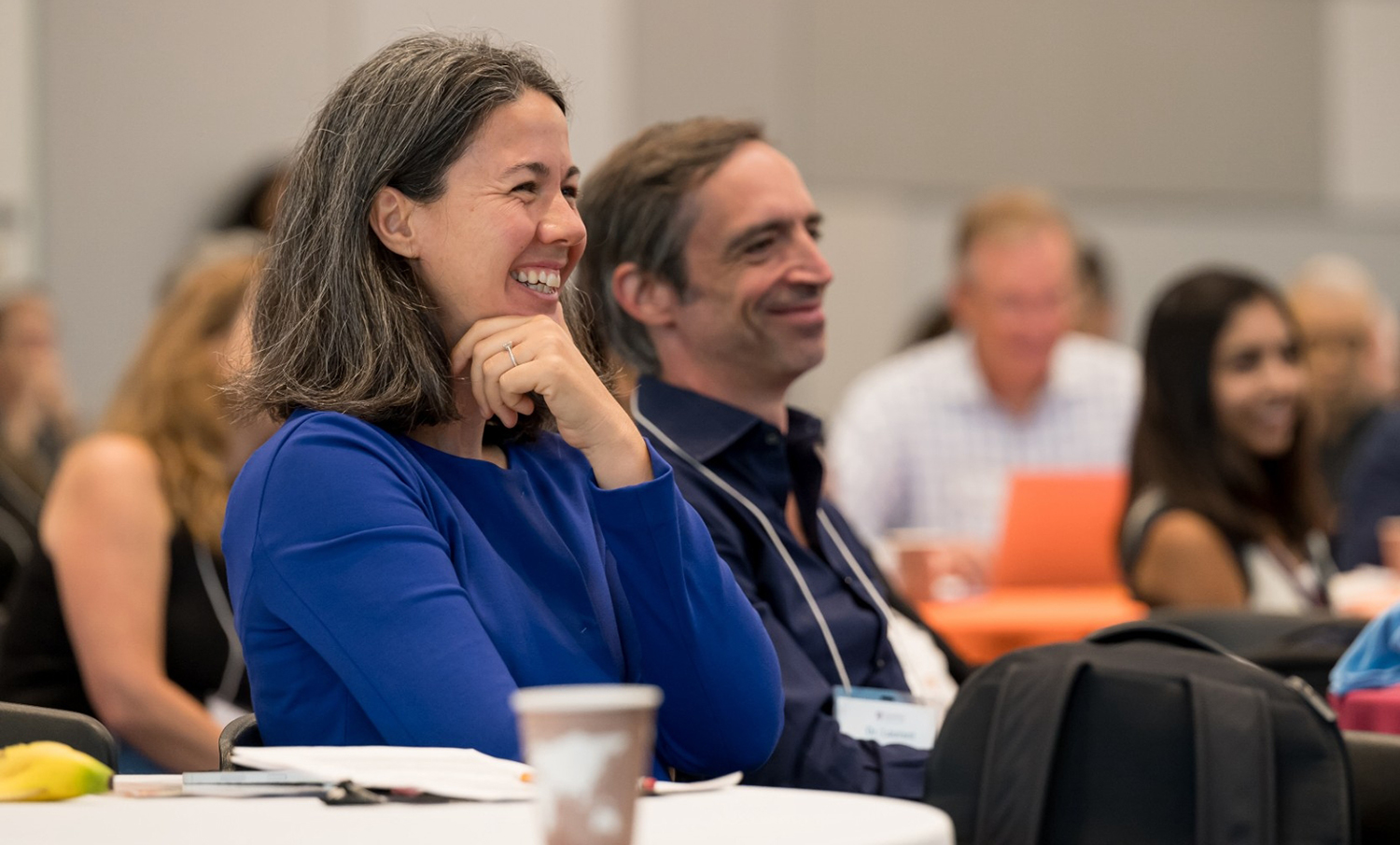From curing all diseases, to consulting patients on new approaches to health care, to using data from social media in training diagnostic algorithms, experts from health care, the tech industry, humanities, and more explored what the future of health care could look like at the Big Ideas in Medicine conference Sept. 6 and 7.
“Big ideas are really important,” said Bryant Lin, MD, a clinical professor of primary care and population health who welcomed attendees at Stanford Medicine’s Li Ka Shing Center for Learning and Knowledge. “I want to share a couple of stories of what I think a big idea is today.” Although he has never smoked, he told the audience, he was diagnosed with stage 4 metastatic lung cancer earlier this year.
“I was in pretty bad shape. I had to be hospitalized. But I look pretty good today – I can talk, not short of breath, not coughing. I’m here today because of a big idea in medicine, which is tyrosine kinase inhibitors,” Lin said of a cancer treatment that blocks proteins controlling cell growth and division. “I attribute my ability to have a high quality of life, to be able to be here and share this conference with you and listen to our fantastic speakers…[to] this really big idea.”
Speakers at the two-day event, sponsored by the Medical Humanities and the Arts Program, discussed a variety of topics that encouraged attendees to reimagine what the health care field could look like, if only some of their big ideas came to fruition. The ideas included using AI to create new antibiotics; the value of compelling, accurate science storytelling; retooling the ever-cumbersome electronic health record; and treating anxiety as a stage of grief.
Addressing the mental health crisis
Vivek Murthy, MD, surgeon general of the United States, shined a light on something he’s called “the loneliness epidemic.” From CEOs, members of Congress, and parents, Murthy has heard about isolation and feelings of being disconnected. “I realized there was something important happening here,” he said. About 1 in 3 Americans struggle with loneliness. Not only does loneliness increase the chance of developing depression and anxiety and contribute to suicide, it impacts physical health, raising risk for cardiovascular disease, dementia among older people, and premature death, Murthy said. It was clear “that loneliness was a public health concern that’s just as important as any traditional concerns, like smoking and obesity,” he said.
What’s missing is quality social connection, the decline of which is likely a result of social media. “I worry that the people who are paying the greatest price for this are young people,” Murthy said. He argues that safety standards and healthy boundaries on technology use are necessary to protect young people and help them build social skills. “When our kids are involved, we have to prioritize safety,” Murthy said. Yet there’s a lack of guardrails for infinite scrolling, visuals that depict self-harm and other problematic content. “That reflects, in my mind, a failure for us to fulfill our most sacred responsibility – to take care of our children.”
Mental health was a theme throughout the conference, with several speakers focusing on physician wellness. It’s no secret that health systems nationally are contending with physician burnout, and the pandemic only exacerbated the problem. Among the outsized contributors: electronic health records, patient messaging, and an overall dearth of providers across the country, according to Lisa Rotenstein, MD, and Megan Mahoney, MD, primary care physicians at the University of California, San Francisco, and others. The distribution of a patient’s care among various doctors and health systems can harm patients and increase stress for physicians trying to navigate a patient’s complicated medical history.

Lloyd Minor, dean of the Stanford School of Medicine, addresses conference attendees. | Kevin Meynell
Those factors contribute to another pervasive challenge in health care – access to care.
Though these problems loom large, health care and technology experts are determined to find – or create – new short- and long-term solutions that build a multipronged support system equally beneficial for patients and providers.
Improving access, inclusion, and wellness
Ilana Yurkiewicz, MD, clinical assistant professor of primary care and population health, has taken a special interest in care fragmentation, in which several clinicians care for one patient without sharing information. The solution, she said, involves “the three Ts,” – technology, team, and time.
According to Yurkiewicz and others, technology must evolve to meet the needs of doctors and patients, such as shareable electronic health records and other tools they can customize as well as consistent coworkers who work with the same teams. If the first two Ts – technology and team – are successfully addressed, ideally, physicians will have the time they need to provide quality care without overextending themselves. (According to the conference’s keynote speaker Amir Rubin, former president and CEO of Stanford Hospital and now CEO of Healthier Capital, health care systems need “the five As” – accessibility, availability, affordability, accommodation, and acceptability.)
Yurkiewicz said that Stanford Coordinated Care, a program for patients with multiple health conditions, embraces the three Ts. Under the program, a physical therapist, a nurse, a social worker, a pharmacist, a dietitian and four care coordinators – all of whom are medical assistants trained on relevant health care tech such as electronic health records – work closely with the physicians. “This is just one example of a successful clinic,” she said.
Rotenstein and others also pointed to technology such as AI-based algorithms that take clinical notes for the doctor and draft patient emails for them to review as near-term solutions.
Holly Tabor, PhD, professor of primary care and population health, emphasized the need to make care more accessible for people with intellectual and developmental disabilities. “Everybody thinks it’s somebody else’s job to take care of this population,” Tabor said. “Health care providers, health systems and society have a moral, ethical and legal obligation to make health care more accessible to full participation by people with all forms of disability.”
Tabor and her colleagues have piloted a project, IDD Transform, to improve health outcomes for adults with disabilities in a measurable way. “We need to listen to people with [disabilities] and their caregivers about what they need, what their barriers are, what they’re not getting, and then use design thinking and other models to think about how we can do a better job.”
Bold solutions
“How can we allow you to be your most creative self?” asked Priscilla Chan, MD, co-founder and co-CEO of the Chan Zuckerberg Initiative. “How can we de-risk things, make things faster so that you can pursue your wildest ideas instead of your safest ideas …?”

Eleni Linos enjoying a speaker’s talk. | Kevin Meynell
The self-stated goal of the initiative, to “cure, prevent and manage” all diseases, sounds lofty, the panelists said, so it’s not uncommon for people to hear that and balk. In science, people aren’t used to thinking about progress on a 100-year timescale, said Stephen Quake, PhD, professor of bioengineering and applied physics, the Lee Otterson Professor in the School of Engineering, and head of science for the Chan Zuckerberg Initiative. But maybe they should start. “We think of grant-level, three-year timescales,” he said during a conversation with Chan. “Part of the initial reaction of skeptical people [is] they’re just not used to thinking about what happens over the course of 100 years. And if you get kind of scholarly about that, you realize a whole lot can happen in 100 years.”
Researchers shared a variety of other tantalizing ideas for the future of health and medicine. James Zou, PhD, associate professor of biomedical data science, spoke about the evolution of AI, from a predictive puzzle solver to a tool that accelerates research by generating protein sequences for therapeutics, creating images, spitting out text, or supplying a variety of other products. Boris Heifets, MD, PhD, associate professor of anesthesiology, perioperative, and pain medicine, shared his exploration of psychedelics in mental health management. And Anna Lembke, MD, professor of psychiatry and behavioral sciences, introduced a new type of self-restriction known as “dopamine fasting,” which requires a person to resist behaviors that release the hormone dopamine (like scrolling through social media or eating junk food) to curb addiction and restore dopamine balance in the brain.
Eleni Linos, MD, DrPH, professor of dermatology, took the stage as a storyteller. In May, Palo Alto, California, was treated to a rare celestial phenomenon: the northern lights. Linos begrudgingly joined a friend for a late-night stroll to a dark hill on campus, only to look up at the sky and see … nothing. “As I started to leave, someone I didn’t know tapped me on the shoulder. They said, ‘No, no, no, take out your phone,’” recalled Linos, the Ben Davenport and Lucy Zhang Professor in Medicine. She found that her phone could capture the beautiful pinks and greens streaming across the sky. “That was the moment where I was like, ‘Oh, this is real-life, augmented reality. This is exactly how it should be in my clinic.’” An AI-enabled app on a doctor’s smartphone, for instance, could scan skin lesions and help them make diagnoses based on details unseeable by the naked eye.
Linos added that years ago, on a flight, she sat next to a blind passenger. Her first reaction was to help – did he need assistance maneuvering around the plane? Pouring his drink? He did not. (It turned out he was a motivational speaker named Hoby Wedler who shared ideas about accessibility and science. He even earned a PhD in organic chemistry by feeling the relationships between molecules.) They struck up a conversation.
“We were flying to the East Coast, so we had a really in-depth conversation about accessibility and how educational institutions need to give more opportunities to people with disabilities, including blindness,” Linos said. They talked about her work as a dermatologist and concluded jokingly that there are some fields that would be extra difficult for a blind person to do. There could never really be a blind dermatologist, they agreed.
Fast forward five years. “That’s totally changed. Algorithms aren’t just as good as a dermatologist; in many cases, they’re better.” Linos reached out to Wedler. “I called him, and I was like, ‘You know what? We were wrong five years ago. You could become a dermatologist.’”
“He doesn’t want to,” she said with a laugh. But it poses new questions for Linos: What does it mean for dermatologists’ practice and careers? What will be possible in five years that isn’t today? “I just want to leave you with that optimism and that question.”